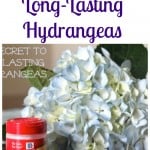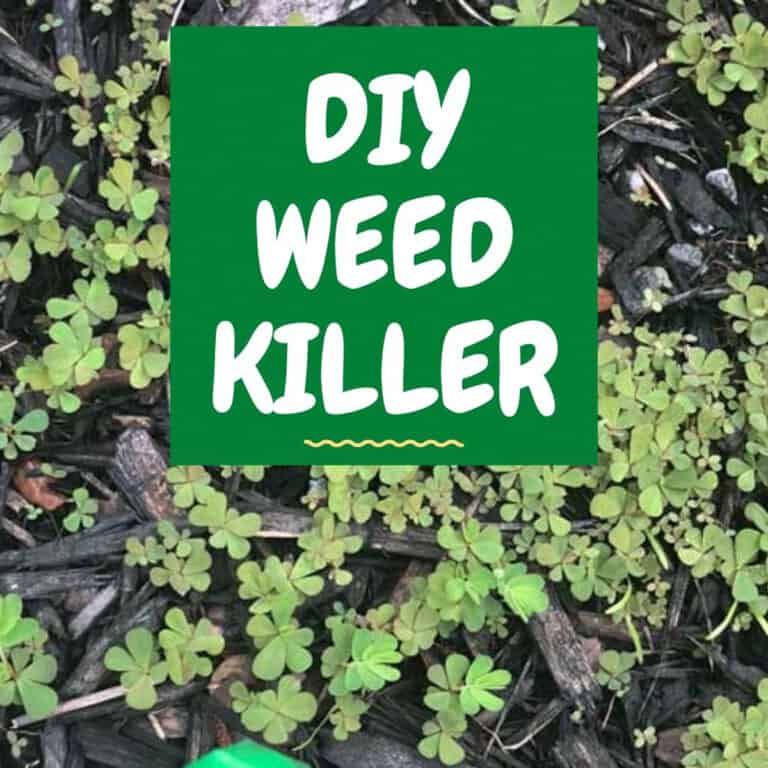The Secret to Long-Lasting Hydrangeas
This post may contain affiliate links. If you purchase through links on our site, we may earn a commission.
How to keep cut hydrangeas from wilting-the simple florist’s trick that can prevent and reverse wilting in hydrangea bouquets!

I love hydrangeas. Seriously, LOVE them. The first thing I did last year when we moved in our house was plant five hydrangea bushes so I could have my own. They haven’t bloomed yet this year but I was super excited to see cut hydrangeas in my grocery store last week and snapped some up for my kitchen table.

How to Keep Hydrangeas from Wilting
Keeping cut hydrangeas used to be hit or miss for me-they’d either do great or wilt almost immediately in the vase. I didn’t know what was causing it or how to prevent it until I was given a helpful tip from the flower vendor at our local farmer’s market last year.
She told me that sometimes when you cut hydrangeas they form a sticky substance over the cut that prevents the flower from sucking water up through the stem (that’s scientific terminology by the way, “sticky stuff” and “sucking water up,” can’t tell I was a Bio major can you?)
To prevent that “sticky stuff” from forming you need the secret ingredient-alum! (A common ingredient used for pickling, find it in the spice aisle.)
When you are arranging your hydrangeas re-cut the stem about an inch above the previous cut and immediately stick the bottom 1/2″ of the stem in the alum to coat it, then arrange as usual. It’s easy and works! No more wilted hydrangea blooms!
Repeat the process any time you see them beginning to wilt and you can keep the hydrangeas from wilting for weeks!

Do you love hydrangeas as much as I do? What are your favorite flowers?
Be sure to check out these other flower posts:








I planted a hydrangeas one day and the next day it was wilting and all the flowers wilted a and died please help me..
I have heard that you can use coffee granules to boost your hydrangea acid level. Do I scratch them into the soil dry from the container or should I perk them first? If I perk them first should I pour the cooking water also around my plants? This would be used only as a supplement to my Hydrangea fertilizer. Perhaps between feedings. Trying to use up 3 containers of frozen coffee granules that have reached their expiration dates.
Hi I have 2 hydrangeas that I planted 7 years ago they have never bloomed again since planting them I get big beautiful foliage but no flowers what do I do to get them to flower
do you cut them each year or leave them? do you know what kind they are? Certain types won’t bloom if they are cut down in the winter. You can also try bone meal in the soil, or take your soil to get tested at your local extension office.
Blooming is tied to Sunlight. It is nature’s food. Also, when you see green coming onto the hydrangea start fertilizing.
Many Hydrangeas, those that bloom on old wood, set their buds in fall. If you trim them back too late in fall, or in the spring you risk trimming off the buds. I have noticed many more blooms since I became aware of this.
Check your soil levels for nitrogen. A high nitrogen content will make beautiful green foliage but keep hydrangeas from blooming.
This works so well, I cut hydrangeas for my daughters wedding. I cut them off of friends bushes and my own and dipped them in alum and put them in buckets of water. I took ten buckets of hydrangeas to my floris, which she used in boquets and arrangements and they all stayed beautiful for the wedding and reception. It saved me a whole lot of money!!
Oh that makes me so happy to hear Shelly! So glad it was useful!
Stupid question but do you put them in water after or Whit no water
Do you put them in water after dipping in alum or not?
Yes, after the alum put the stems in water as normal.
Do you keep hydrangea in water after dipping in alum?
How do you change the color
you have to change the pH of the soil: acidic soil, with a pH lower than 6.0, makes blue or lavender-blue hydrangea blooms. Alkaline soil, with a pH above 7.0, promotes pinks and reds. With a pH between 6 and 7, the blooms turn purple or bluish-pink. To lower your pH, add garden sulfur or aluminum sulfate to your soil. To raise the pH, use ground lime.
Havr blue rangeas near north wall. Also pink in a sunnier spot.with shade. What I love is that they bloom for long period.